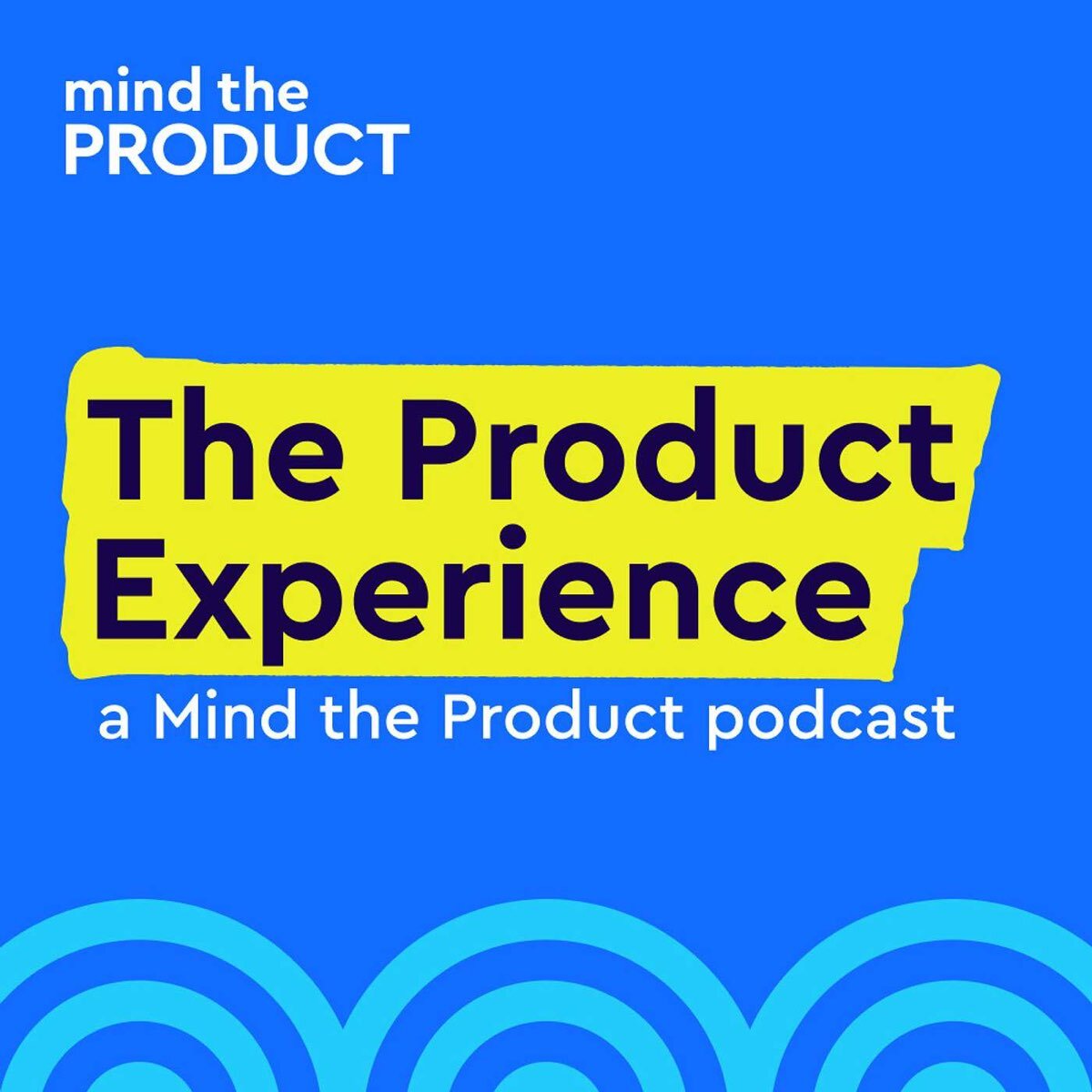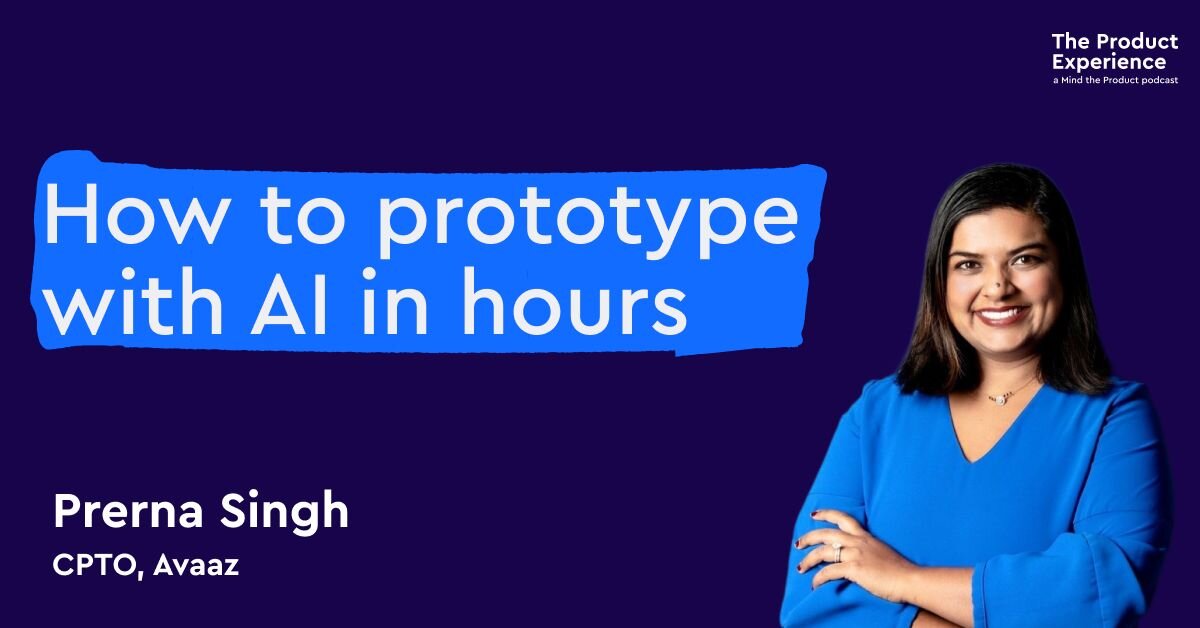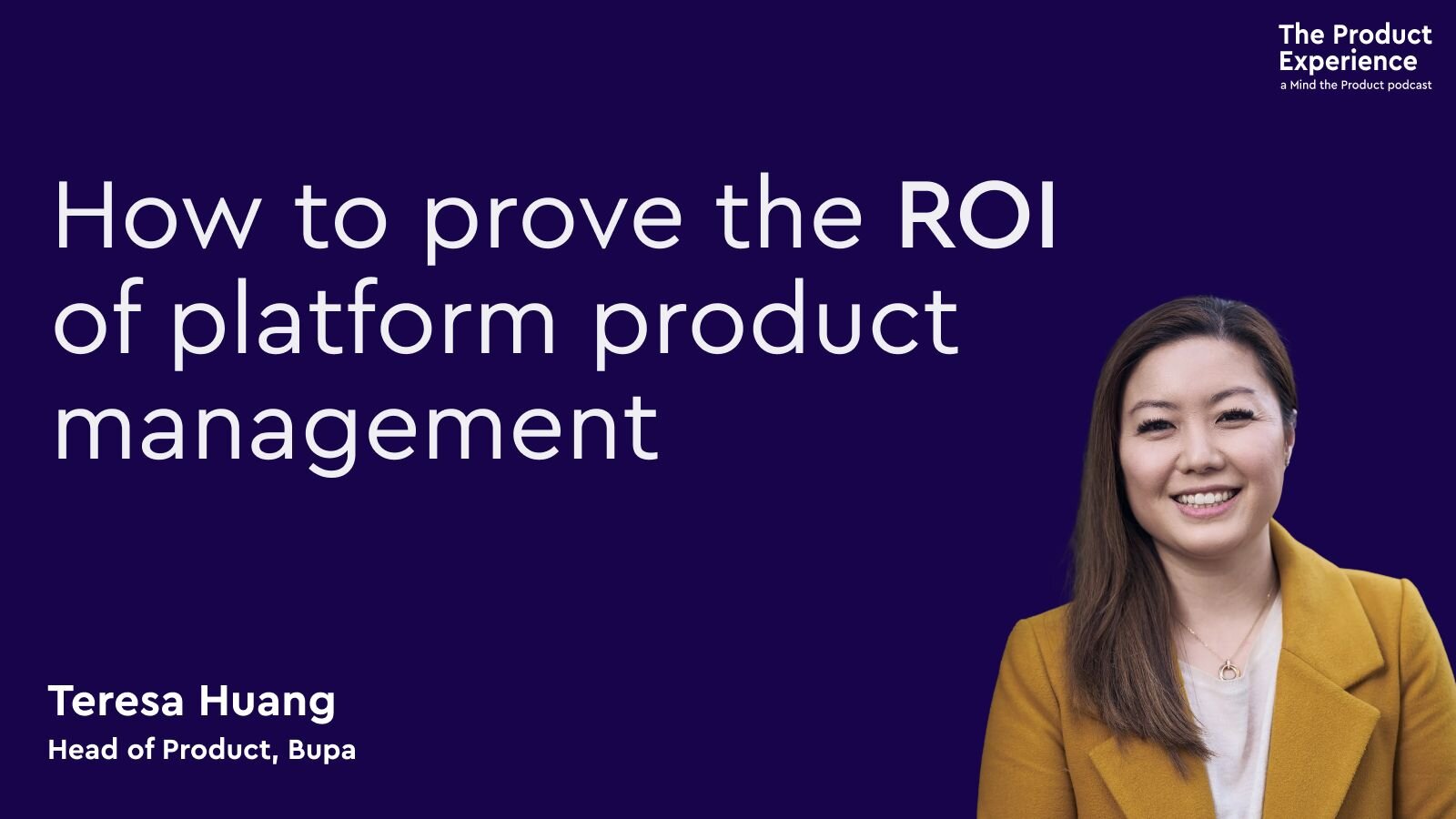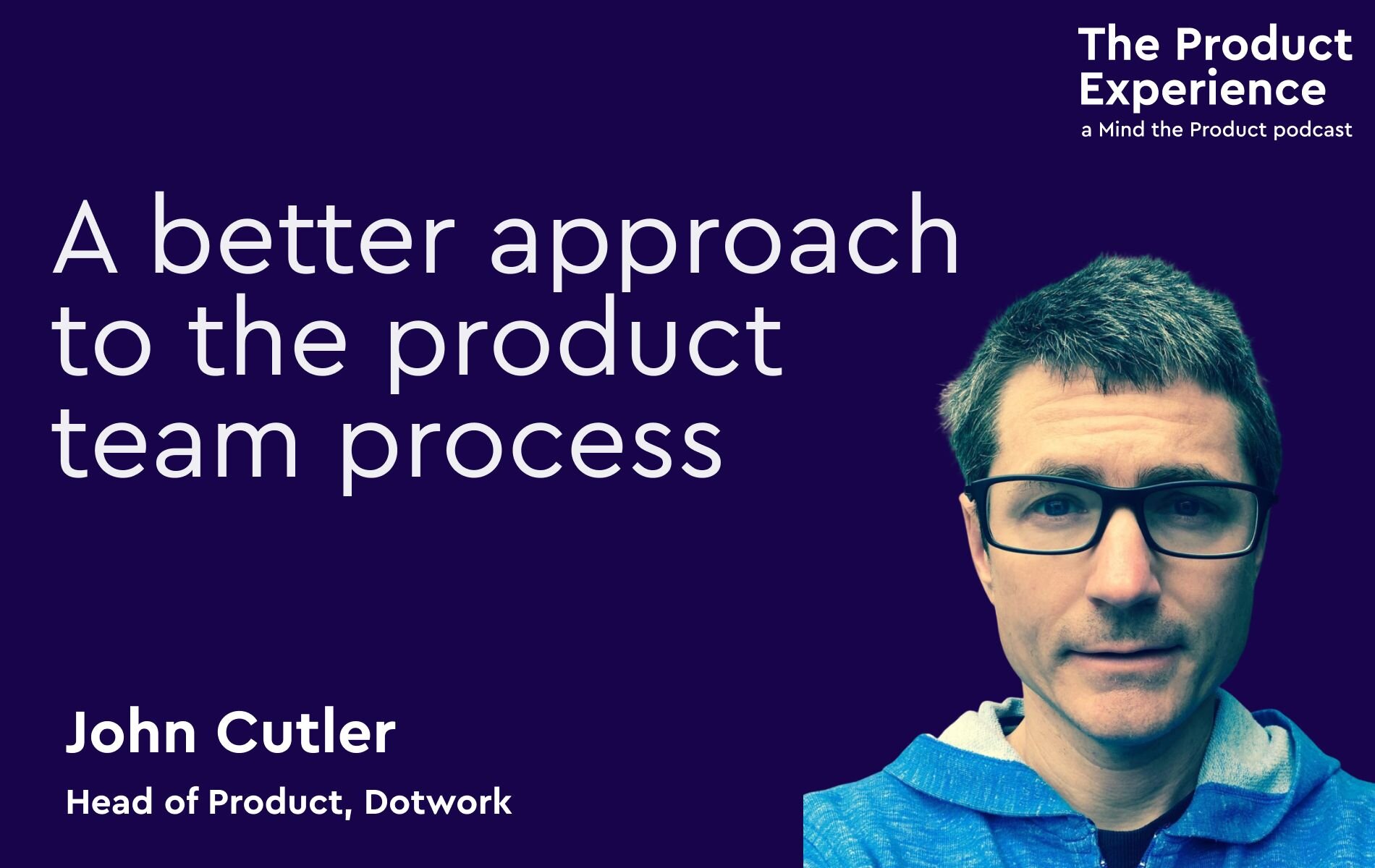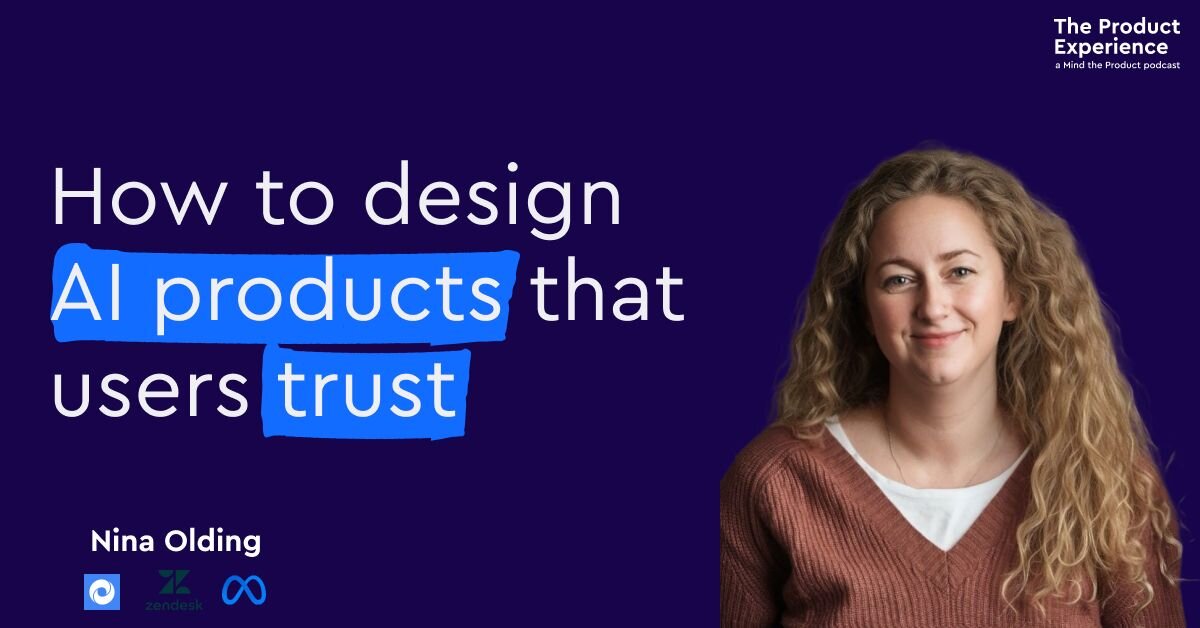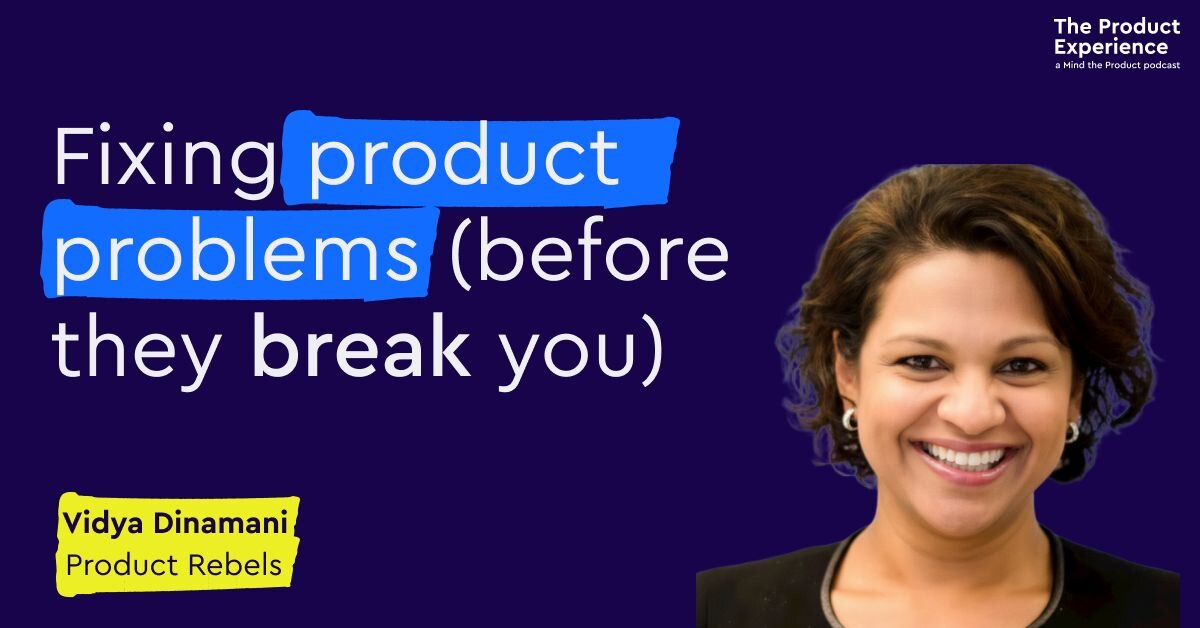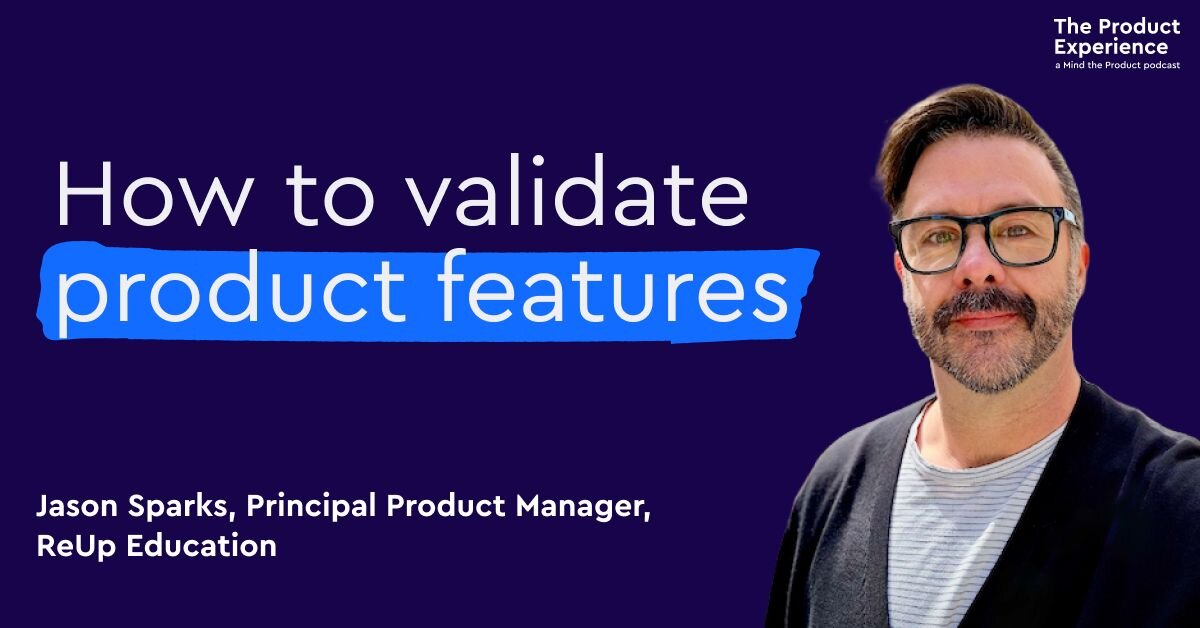Rerun: We learn something from every guest that joins us on the podcast, but it’s not that often that something they say makes it onto our wall. Dave Martin (co-founder of Right to Left) chatted with us about building great habits for product people, and how to make sure they stick. He also tells us about his simple question to ask at the end of every week – something that’s already made a difference to the way we work!
Featured Links: Follow Dave on LinkedIn and Twitter | RightToLeft | Marty Cagan's books 'Inspired: How To Create Tech Products Customers Love' and 'Empowered: Ordinary People, Extraordinary Products' | Professor Alison Wolf on 'Not Accepting Good Enough' video | Gallup's book 'First, Break All The Rules: What The World's Greatest Managers Do Differently'
Episode transcript
Randy Silver:
Hopefully, this podcast has become a bit of a habit for us, hasn't it? It sure has
Lily Smith:
Randy. And like all good habits. When you don't get your fix, you kind of feel a bit sad. Unless it's a bad habit, I suppose then you feel sort of sad and happy at the same time.
Randy Silver:
And this week, sadly, with all the seasonal bugs going around, we didn't get to interview our planned guests. I mean, it's okay. They're recording with us next week. But there's some good news too.
Lily Smith:
That sure is because we're going to rerun the great episodes we did with Dave Martin about the habits of successful product managers.
Randy Silver:
Maybe you listen to this episode when it aired oh, about a year and a half ago, and loved it. But we all know that habits need to be revisited from time to time to really sink in.
Lily Smith:
And this is a good one. So maybe we should make talking today for habit. The product experience is brought to you by mine the product. Every week on the podcast we talk to the best product people from around the globe. Visit mind product.com to catch up on past episodes and discover more.
Randy Silver:
Browse for free, or become a mind that product member to unlock premium content, discounts to our conferences around the world and training opportunities. Mind the product also offers free product tank meetups in more than 200 cities. near you. Hey, Lily, I've got some good news.
Lily Smith:
Oh, I love good news. Randy. What do you got?
Randy Silver:
Well, 2020 is over. Done. It couldn't have happened soon enough. But you know, I will admit that I feel a bit like Punxsutawney Phil or Staten Island Chuck.
Lily Smith:
I felt like I should know those names. And I'm a bit afraid of where you're going with this.
Randy Silver:
Come on. Those are the famous groundhog Punxsutawney Phil's though groundhog and Groundhog Day. And Staten Island Chuck is from my hometown. And they're the ones that predict the weather on Groundhog Day. And I feel like I'm not sure if we're predicting you know, a few more months of staying inside or a whole nother year.
Lily Smith:
Oh no too soon, Randy. Let's kick the new year off with something much more appropriate. And conveniently enough, we have just the thing for that on today's part. We talked with Dave Martin, the founder of Right to left and the former chief product officer at Tez. About how to form good habits for product people. Over
Randy Silver:
this was a good one. I have a sticky note up on the wall with one of my favourite bits from this chat. And I'm swearing that I'm going to use it every week.
Lily Smith:
Well, that's one good way to form a habit. So let's dive right in. product experience is brought to you by mind the product.
Randy Silver:
Every week we talk to the best product people from around the globe about how we can improve our practice and build products that people love.
Lily Smith:
Is it mind the product.com to catch up on past episodes and to discover an extensive library of great content and videos,
Randy Silver:
browse for free, or become a minor product member to unlock premium articles, unseen videos, AMA's roundtables, discounts to our conferences around the world training opportunities and more.
Lily Smith:
mining product also offers free product tank meetups in more than 200 cities. And there's probably one near you.
Randy Silver:
Dave, thanks so much for joining us tonight on the podcast. Just for a quick intro for anyone who doesn't already know you. Who are you? How did you get here? And how did you get into product? What do you do these days
Dave Martin:
are there and they will thanks for having me on the podcast, I listened to it pretty much every episode. So looking forward to being on it. I don't get into product. Well, I've spent the last 20 years or more the remains too long in product development. And the last 10 years or so mainly been in product leadership roles, including Chief Product Officer over at a pretty large private equity, global ed tech that was called test. And so I've spent all my time pretty much on that balancing act between technology and business, making sure that we're investing in the right things to help the business achieve its goals, which 20 years ago, we didn't call product management. But today we do.
Randy Silver:
Fantastic and it's that experience that we wanted to talk to you about because you've got a lot of experience in evaluating product managers and in hiring them and recruiting them. So we're curious, what do you look for when you're evaluating a product manager? How do you know if someone's any good?
Dave Martin:
Well, that's a million dollar question handing over a good one. If I was that I'd be the best recruiter in the world instead of instead of a product management coach, but you know, it is true. It's there. I've spent a lot of time hiring and lots of great teams and Now, right to left the company I founded, we audit and help companies understand how good they are themselves too. And that I think, you know, one of the tough things is that it's not one size fits all. And like perhaps other sectors that we could be in, you know, other other career choices and vocations. You know, it's unlike passing your exams in finance, and everybody does corporate finance the same way, product isn't quite the same as we all know. So I think, first of all, we've got to understand what this whitespaces product score fits in that organisation. And then perhaps the next thing that I personally look for on individuals, instead of perhaps their competencies and skill sets, I'm more interested in looking at how adaptable they are. Because that whitespace changes, and so does the product. You know, when you launch a brand new product, and you're trying to find product market fit, it's a completely different way have different habits and different techniques, you need a different way of thinking different attitudes and behaviours. So perhaps when you're a product manager looking after a growth product, trying to optimise growth and scale,
Lily Smith:
do you have any particular signals that someone is more adaptable or, you know, not suited to product and not adaptable?
Dave Martin:
I think when you think look at people's behaviour, it's the key. There are certain traits, I think, which are really common. I know perhaps later on today, we can talk about some habits that people do. But it's that thing of having really good habits and changing your habits. And that trait of not having a big ego, and being open to self improve, and being open to continuously improve what you're doing. It might sound a little pompous, but really be ability to think in the meta, which, which put a different ways about critical thinking. And critical thinking is the application of appropriate skills and strategies in order to obtain the desired results, ie not just doing the same thing every time. And product managers have to be able to critically think, and instead of perhaps more of the definition of critical thinking, and put it more English, it's about how product managers and teams rethink their habits on a reasonably regular cadence, not weekly or monthly, but at least annually. And then practice those new behaviours to form those new habits. But that's where the trick really gets hard. Because that rethinking isn't is really difficult had you rethink your product process and you rethink who you are as a product manager? And how do you even go about that, you know, it's not like you're rethinking some other skill set, where it's, there aren't many pointers to help us. And that's where we've been doing a lot of work in the company, I've run now, building out something called the product Mindset Profile. And we've called it ethical, it focuses it lets you evaluate yourself, it's free to we're about to launch and let you evaluate yourself, and see where you over index and when you enter index across six Pacific characteristics, six Pacific, we call them mindsets, but they're really behaviours, attitudes. And that's empathy, process, imagination, commercial, analytical and learning. And this helping product managers adapt those particular characteristics based on the goals they have. And that's a really interesting space to plan.
Randy Silver:
So let's dig into that a little bit. Because we're all guilty of making product management sound like it's the end all be all and this amazing, the important thing, and sometimes I have to remind myself that really, we're just middle managers most of the time, and we're working within the company within with lots of other people. So what are some of those habits, aside from reining in that ego? What let's talk about one of the habits that you look for and tried to develop in people that may help make them really effective.
Dave Martin:
Yeah, I think that perhaps the starting point is to think about what habit is, and then go into that, you know, and when I told my daughter, we were having an interview tonight about habits, she looked at me confused. What we got my we're talking about priests and Vickers clothing. So, you know, it's just about their routine behaviour, what's my routine behaviour? And what routine behaviour do I do with I don't really have to think about that. That would be what I mean by habit. You know, there are a bunch of great habits that and I think they're not always, they're not all needed for every product manager at every specific part of their journey. But by journey, they mean their individual career, I mean, the journey for the product that we're overseeing, and the business goals they're trying to achieve. But there are a few that stand out as those sort of lifelong habits. Just like if we were talking about being healthy, there are a few life Long habits to being healthier, which will always stand you in good stead. So thinking about your diet in a certain way will always do well. And I think there are a few of those in product that we could dig into. And perhaps the first and most obvious, but unfortunately, from my experience, the one that is least practised very well, and isn't a habit for many people, is talking to customers, which sounds crazy that that's not a common habit. But given all the books that all these amazing people like Marty Kagan, etc, right? Talk about the process of talking to the customer and learning from the customer. But it's not a habit many people have.
Lily Smith:
What do you think it is that holds people back from talking to customers? And how do you support product people in trying to improve that very important habit?
Dave Martin:
Yeah, I think it's really interesting. For a while I run this process in teams of companies, when I was helping companies go through transformation, and more recently coaching. And helping teams grow around this process where we got, we evaluate got the team to evaluate themselves on a bunch of capabilities, and things they do and activities, about the knowledge, do they have the knowledge to do this thing. And that's where we'd start. And they teams would always tell me how they knew how to run experiments, knew how to talk to customers, etc. And then we do exactly the same process. But the topic would have changed slightly to what you actually do not know how to do so, and the game that, you know, talking to the customer would be really low along with running experiments. So the it's not knowledge. It's not that they don't know how. But that's the interesting thing about learning. It's not always about the expertise of how to do something, it's not always the knowledge, it's the practice of the practice of actually doing it. I've done a lot of reading in this space. And there's this fantastic economist called Alison Wolf. And she observed this problem to do with people learning vocational education, and focused she looked at, like music teachers have pointed out the good teachers of music. And this is a direct quote from our utterly disinterested in good enough. They're really obsessed about things being great. They don't have low expectations, they just don't do low expectation. I think there's a starting point that we miss don't necessarily always think about the key things in avocation as product managers and like these key habits like talking to customers, as something that we can we, we accept that it's okay, we don't do it. So I think that's the first starting point, accepting that that's not good enough, that it's non negotiable. And you're not doing your job, if you're not doing that is a start is a starting point, which can be a home truth for people. But the next thing is fear, always the same. It's always nearly always the same conversation. In the last year, I've probably helped 100 Odd product managers and team in across different teams, both in the UK and US. And every single time it's fear, they'll come up with excuses. There'll be problems, like, we haven't got access to the customer. That's sometimes one is not always one. But it's sometimes when it's often not very hard to get over, just bring the CRO up talk about why and why you want to talk to the customer. And now you're allowed. It's pretty easy. But it's normally fear. It's the fear of what do I say? And you know, I'm not an eight pound sales guy. I'm not used to this emotional challenge. And a few of us are really good at networking and extrovert and comfortable with it. But most people in the role aren't. They're really nervous. They need that hand holding, they need to help they need some support in getting over that emotion.
Randy Silver:
Is it fear of talking or fear of what you might hear and what you'd have to do with that information? Well,
Dave Martin:
I really wish it was what you just said, Randy. It'd be over the moon if it was fear of learning that I got something wrong, because that would be a phenomenal discussion. Because that's the whole point, isn't it? And I'll point of talking to somebody is that learning velocity? Like? Often the question is often well, how often should I talk to customers? And my answer is always, well, how often do you want to learn? How often do you need to learn whether you're doing the right thing? In my opinion, it's typically at least once a week, but not once a quarter or once a year as it often can be? So no, it's I think it's actually much more of more basic human fear of I don't want to look stupid, I don't want to sound any dear to you know this not the normal things that make people anxious, and we sometimes forget that they exist. We almost forget that. Just because I've got this title and job title and all these responsibilities. I'm still human underneath with the same fears and anxieties, anxieties that everybody else has. You know, that fear of just looking stupid is enormous. I've helped a few people get through it by simply doing it with them to start with taking the call with them and then swapping.
Randy Silver:
It's interesting because I hear exactly what you're saying, I'm not going to fight with you about it. But I'm seeing it from the other side as well, where people aren't necessarily afraid to engage with a customer, it, they then learn something that challenges what the received wisdom is inside the business. And then they have to do something with it, they have to tell other people this, they have to tell their stakeholders that they're wrong. And they're terrified of that, because they did it once and it went badly, or they're somebody else do it badly. Wrong.
Lily Smith:
interest interested, I feel like it's such a kind of big topic, and one that so many people kind of struggle with and at different points in their career, and to varying different degrees as well, we could spend quite a lot of time talking about habits.
Randy Silver:
Way off topic. Sorry, guys.
Dave Martin:
I was gonna say, Randy, I mean, if we think about some of the other habits, it might help with that major point of fear inside the organisation, and the fear of telling my boss, they've got it wrong, or upsetting the founders, you know, and if we look at some of the other habits that are really important for people to do, writing down assumptions would be one that would help with that exact problem that you've just mentioned, the amount of teams that just don't know what their assumptions are. There's the great teams, the teams that work brilliantly, I can talk to them. And they'll tell me what this is the assumption of why we think this thing is right. And then they like can be challenged through conversation. And then that can introduce another great habit, writing down hypotheses. And that challenge becomes hypotheses, which then becomes experimentation. And that leads into the habit then of sharing the learnings, from experimentation and from interviews. So I think those thinking about those habits, right, writing down assumptions, writing down hypotheses, and sharing learnings from experiments, they all help massively. If that's the if there are things you do all the time, that completely changes that conversation with senior management, and the business, in fact, that puts you in the driving seat, because those people don't have that evidence.
Randy Silver:
Is there a secret to making a habit of these things other than, you know, just doing it?
Dave Martin:
Well, I think there is definitely an if you do some research, which I've spent a lot of time looking at how people form habits and how you keep them. And, and if you look across it, like coaching for athletes, and people trying to lose weight, and this area are people trying to quit booze, there's a bunch of good research on habit forming on how to do it. And it's not as complicated as it might sound. It's ridiculously simple, actually. Unfortunately, it does require some discipline. And the first thing is to set a goal set and define a clear goal. And that goal isn't isn't I want to form this habit uncovered is why you're doing this thing, what was the thing you want to get out of it, maybe some part of the goal is for your business, but part of the goal has to be for you as well, personally. And then once you've got a really clear goal, it's about deconstructing that, to understand what that target condition is, but what you've got to be able to do on a regular basis to to achieve that target condition. That's the deconstruction. It's not just listing off a load of checklists and capabilities, it's what deconstructing almost the skills, you need to be able to achieve that goal. And then you can evaluate your current condition. And then with that, you can then set yourself very clear, scheduled time of when you're going to practice to form that habit to create the habits as experiment or they're effectively experiments, you need to have very clear time to practice it and schedule and commit to, so you can't purposefully form lots of habits at once. We don't have the bandwidth. But you can purposefully form one or two habits at a time. And setting that time to practice making sure that when you are practising that habit, you're doing it in a good environment i You've turned off slack notifications. If people still have email, they've turned that off too. And your phone is off, I guess if that rings, which would probably shock most people. But they focus on their habit and practice it and then review and track whether they're doing it track. Am I doing this regularly for how have I done it and how am I feeling about it? Is it getting better? Is this thing getting easier? Is it becoming more easy for me? And typically, the research suggests that it takes roughly 21 days, three weeks to form a new habit when you purposefully and actively try to do it. After the 20th after the third week. It doesn't it no longer feels hard work. You've got over that curve of discomfort. But or if you look at it a different way we could consider it to be about resilience. You've got yourself a comfort zone for a little while. And it takes you roughly three weeks to for that position of being out of your comfort zone to become your new comfort zone. And that helps you drive forwards the new habit is that was practising it every day. Yeah, pretty much every day. Yeah. Yeah. So it doesn't obviously, habits in the business world might take a little longer, because some things don't happen every day.
Lily Smith:
And what about because a lot of these things that you've mentioned about, you know, talking to customers writing down assumptions, sharing learnings from experiments. They don't necessarily have to be things that you do as an individual, it can be more of a team situation. So how do you find people kind of developing habits in within teams? Does that make it easier or harder or
Dave Martin:
it makes it easier? Obviously, the word always depends by the standard answer for product manager, everyone. But in reality, I think typically, it makes it easier. And it makes it easier, because you've got some extra things by default that you need to do this. Well. You know, if you think about that athlete, they need support emotionally, through the pain through the app being out of the comfort zone, they need to be able to talk through their failures with somebody, they need to be able to focus on their performance, and they need to be encouraged to reflect on it. And in a team environment, a good team anyway. And by team, I don't mean just a bunch of people that are put in a room to work together, I mean, an actual team that works together to achieve goals and support each other and communicates, then you're going to get an awful lot of those things. By default, you're going to get them automatically, you're going to have that conversation with your team members, that provides you that emotional support that you're going to chat through the things that didn't work properly in retros. Another good habit, probably in retros, and be able to talk through the failures. And you may have to focus on the performance, maybe in standup regularly, another good habit turning up Stand up focusing on those performance issues of around what we're looking to improve. And the nature of retro etc, automatically encourages reflection. And so just teamwork. It encourages people comparing and asking you and challenge you that support and challenge framework that good teams have will automatically give you a better environment in order to form good habits. So you'll probably form them not only quicker, but also stronger.
Lily Smith:
So how can people understand how good they are? Now, at some of these, some of these habits, you know, I mean, I write down assumptions, but I don't do it very purposefully or mindfully. So I wouldn't really know how to score myself on whether I'm good at it or bad at it or so how do we evaluate ourselves on these different habits?
Dave Martin:
I think there's probably two different ways of looking at it. First of all, the fact you have the habit at all, is a good thing. So reward is a really important part of habit forming. We know it's really important that you reward yourself and recognise you're doing well. So if you're already doing it, there should be a big thumbs up you know, we we should be high fiving that somewhere,
Lily Smith:
I was thinking oh, like a bar of chocolate for every
Dave Martin:
Yeah, bar of chocolate bar of beer for Randy whichever fits best.
Randy Silver:
That's probably a bad habit though.
Dave Martin:
You've got to reward the fact you're doing the habit in the first place. If you're doing it well, the Fed doing something, how you then explore it is really down to whether you feel you if you did that thing better? Would it help you with your goals? And would it help you achieve what your goal is, your goal isn't to do that thing better. Your goal is a bit bigger than that. Maybe it's to do with the actual product goals. Maybe it's to do with your career goals. But we're all doing this individual thing helps you marked if you want to do it better, and improve that habit. And what does great look like and reflect reflecting on that against your goal, comparing it to the impact it might have on your goal. When picking habits to improve upon, I would urge people to think about the value it has the impact versus their desire. Why will you enjoy doing this thing, because if you aren't going to enjoy doing this thing, you're never gonna really going to force yourself to make it a better habit. It's going to be one of those things you have to feel procrastinate on. And one of those things you'll do when you really, really have to, or if you can't delegate to somebody else. So you know, if you're going to really shine, shine, find the things that are going to have an impact and the things that you desire to do better at and then pick one or two of those and focus on those to improve upon.
Randy Silver:
So would you say all of these areas that you measure? Are they equally important? Or is it situational? Is it depend on? What do you need to help you overcome or achieve a certain goal?
Dave Martin:
Yeah, I think it's definitely situational. Randy. I mean, when we look at the product Mindset Profile, we've created the the epical characteristics they change, they're not the same for everybody. We do work as a big companies consultancy company with organisations to understand which of those attributes they need right now, in order to succeed at their goals. And if you're looking for product market fit, you want to be over indexing on things like empathy, imagination and learning. But they aren't the things to over index on necessarily nice, not strict rules, but they aren't the things to over index on necessarily, if you're looking to scale up pace, you probably need to think more about process operations, that kind of think you'd definitely be thinking more commercially, you know, the cost of the impact on costs, etc, the margin lines, and you've probably got to be a lot more analytical. So there are different characteristics depending on context. And those contexts will change, not only just based on your goals you have but it also change on the company you're in, and it will definitely change based on your leader. You know, if your leader isn't purposefully nurturing these, specifically thinking about what's important for you, and for your product line you look after, and the stage of the organisation or the stage of the product you're on, then they'd be doing it in an organic way. And it's just their natural leadership signature. And that means you all end up influenced by them, your beliefs, and things are more important than others, just because that's the leadership. And that's what they're rewarding you and encouraging you to do, you can't really not you're heavily influenced. So leaders context, and the situation you find yourself in will, together, decide what the congruent direction is really,
Lily Smith:
just to a point you sort of made earlier about, it's much harder to develop a habit for something that you don't enjoy, or kind of aren't excited about. But if you're if you're evaluating yourself on all of these different aspects in order to improve what you know, would you should you then just prioritise the ones that you're already good at and get better at those or try and fill in some of those gaps? Because I would imagine that in many of these cases, the ones that you enjoy, you're gonna have got better at anyway, or the ones that you've kind of got a natural inclination for, you're going to just evaluate yourself a bit higher. So surely, the best thing is to find the ones that you're not so good at and focus on those ones.
Dave Martin:
I mean, that's a really interesting question to do with personal development, and probably somebody far more knowledgeable on the topic than me could talk about it for hours and hours. I think there are there's two different approaches. And it really depends back to that goal. The goal isn't be good at this habit. The goal is whatever you've said, whatever your personal goal is, and if you're, if the habit is impacted, has high impact to that goal for you imagine like a quadrant a two by two grid of impact versus desirability, if it has high impact. And you know that I really do have to develop that to achieve my goal, you're gonna have to do it. Much like a guitarist who wants to solo and be the lead guitarist in a band, they've got to learn their scales, and it's boring, and they have to do it. But if they can't, they can't move across the fretboard in the right key and improvise a solo making them they'll miss their goal. So is it desirable to sit in practice and learn scales properly? Not on so I think the it's really back down to the low hanging fruit is to pick off the ones that are impactful and desirable when you're starting out trying to think about this and improve. But no, it's something you're going to have to deal with some of the things that are less desirable just like losing weight, you've the gold is losing weight. And is it desirable, not to eat chocolate and kebabs, probably less desirable. But if you want to lose weight, you're gonna do it. And so he's back, it's always gonna be framed to that goal.
Randy Silver:
So given the time of year that we're recording this and putting this episode out, Dave, it's around the time that people usually make resolutions and try and start new habits. But we all know that those typically don't last. So you said people need to repeat them for about three weeks on average, to really make it ingrained. But aside from just doing it the first time, are there any other tips that you have to getting into a new habit doing it the right way?
Dave Martin:
Yeah, there's I think the teams we work with, when we coach teams, it's we track we spend a lot of time helping them track what they're doing. So that it's very Very, very visible when they either don't do it and they can, or when they do it so they can see the reward, the gain and the benefit, or they can see the problem its cost. And if you speak to like a PT, and you're trying to lose weight in January, you'll be encouraged to start with not to stand on the scales everyday, because you won't see any difference. But it won't be long before you're encouraged to stand the scales every day, because they will need to pick up the fact you were you misbehaved, and the behaviour wasn't quite right, and you had an impact, there was a result to that. Not create following the habit you wanted. So it's the same here. It's the same exactly the same. It's about focusing, it's harder to measure. Unfortunately, it's not quite as easy as staying on the scales. But you can at least track did I do that? Did we do this thing. And did these sub goals we because of doing those achievements happen or not? And being one's really simple tool we've used a lot with many teams, it's just a simple matrix, where every week, they tick a box in three in three boxes. They tick one tick, so they've got pick one, which one of these three, did they do this week? Did they create value for a customer? You can't do that unless you release an actual product into the customers hands? Or an update? Did they learn? Or did they do something else? And they track those three things? And then the conversation becomes what was the something else? And why? Why wasn't it learn or create value, because what else was more important, and that then forces them to think about, we didn't do these things we didn't we didn't talk to customers this week, which is why we weren't able to tick the Learn box. Ticking the something else box is pretty negative. It's the equivalent of the Pounds going up or the kilos going up on the scales,
Randy Silver:
itself, like the star chart I had for my child when he was being potty trained. Well,
Dave Martin:
we're all human.
Randy Silver:
If you get it right,
Dave Martin:
provides the really very simple way without complex metrics and teams getting obsessed about some fake figure. Because they've come up with all sorts of numbers, it'd be like agile teams talking about oh, we've increased our velocity by three points we'd be doing could have just estimated them all three points bigger. And you would have done that. So meaningless. That it provides a really subjective mechanism. And it's not for anyone else. It's not for some manager to look at it for the team to look at or the product manager to look at themselves. And go, this is for me to reflect on to then look at did I do this habits I was meant to do? Did I do the things I said I would do. Because don't forget when we when I get involved helping teams, there is always a sense that they want to improve. Because as a coach, we don't work with people who don't want to be coached. And if you want to be coached, you want to improve. So I'm kind of lucky in that sense that I don't have to deal with the people that don't want to be don't want to improve.
Lily Smith:
Actually, that's a really good point what you know, have you ever had to deal with people who or manage people, you know, don't see that they need to be improved? And just happy kind of cruising? Or? Yeah, definitely.
Dave Martin:
I mean, if you look at like general management and leadership, and it's a bit old now, but years ago, there was a Gallup survey called the seven rules. And they focused on exactly that, there was some specific measurements, they took across lots of companies, overall managers behaviours, and found that companies where managers felt like they had to always improve their staff and their staff or wanted to become them to do their job, instead of respecting the fact that a waiter could just be want to be a good waiter. And that's that, they found that that was a huge differentiator between high and low performing companies. So I think there is a difference, though, between doing the job and an adequate level. And doing that being the best you can possibly be. And it's perfectly fine. I don't have any issue with a team or an individual not wanting to be the best they can possibly be, they do have a life outside of being product managers. But they're, it's not acceptable if they're underperforming. And that's, that's where the challenge comes in. So managers should, in my opinion, their job is to help individuals be the best they want to be. And you know, if there, if there is a delta between what they've how good they want to be and how good the company needs him to be, then his manager's job is to make sure that the individuals know that exit them if that's the case, unfortunately, they've got to get the right fit.
Randy Silver:
So Dave, before we wrap up, says people are about to start another year and try and get better at what they do. Is there anything you'd like to leave them with? Is there something inspirational that you have for for our listeners?
Dave Martin:
I mean, first of all, we should always point out that they're probably doing an amazing job, and product management super hauled. So well done for just doing the job, full stop. We're talking here about excelling and became to help you on your journey to being an elite product manager. So if you're not doing all these things, don't worry, I'm going when you read the elite SAF status, you will be, I'm sure. But I think probably the best thing to finish on is my favourite quote. And it's a quote about resilience, and motivation. And it's from Winston Churchill. In fact, I once was running a startup as founder of a business and things were going tough and my wife frame this for me, because she knew how much I liked him put it in a frame like that on my desk. So I looked at it quite a lot. And so a successful man is a man that gets up after being knocked down with no loss of enthusiasm, obviously, this man or woman, so I think, focusing on that if things go wrong and isn't quite going as well as planned, and the total 21 goes a little bit better than 20. If things don't go quite as you planned, that's yourself off, jump back up, and worry about it that some of them are going.
Randy Silver:
That's fantastic. I think 2020 Definitely knocked us all down. And if we can start 2021 Jumping back up with the same enthusiasm. We'll all be in fantastic shape. Dave, thank you so much for joining us. That was really inspirational. That was really fantastic.
Dave Martin:
Thanks very much, Randy.
Lily Smith:
The product experience is the first and the best podcast from mine the product. Our hosts are me Lily Smith, and me Randy silver. Louron Pratt is our producer and Luke Smith is our editor.
Randy Silver:
Our theme music is from Hamburg baseband pow. That's P AU. Thanks to Arnie killer who curates both product tank and MTP engage in Hamburg and who also plays bass in the band for letting us use their music. You can connect with your local product community via product tank, regular free meetups in over 200 cities worldwide.
Lily Smith:
If there's not one near you, maybe you should think about starting one. To find out more go to mind the product.com forward slash product tank
